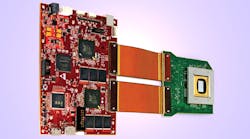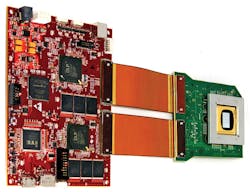DLP (digital light processing) technology, initially developed back in 1987, has been used in a range of applications, such as projectors and large-screen HDTVs. It has even been used in tiny picoprojectors.
I talked with Gina Park, product line manager for DLP catalog products at Texas Instruments, about DLP technology and where it is headed.
Wong: How has DLP technology evolved over the years?
Park: It’s pretty amazing that a decade ago, people were disassembling projectors to get access to the TI DLP technology inside. Engineers saw the great potential of millions of micromirrors intelligently steering light. And, out came a variety of innovations that were more targeted in industrial and medical applications, such as spectroscopy, 3D machine vision, and 3D printing.
This file type includes high resolution graphics and schematics when applicable.
We’ve progressed quite a bit since those early days. TI now offers a full portfolio of DLP chips and evaluation modules (EVMs) so that people can have easy access to work with this unique, spatial light modulation technology.
Wong: Tell us more about your new high-resolution chipsets.
Park: The DLP9000 (Fig. 1a) and DLP6500 (Fig. 1b) are the latest high-resolution digital mircomirror devices (DMDs) in our portfolio of chips made available to the broad market. It’s important to point out that these chips are paired with a DMD controller, the DLPC900. This gives users the ability to run at pattern rates up to 9500 Hz for high-speed data acquisition. And the DLP9000 and DLP6500 offer an expanded wavelength range of 400 to 720 nm. This suits them for 3D printer and digital lithography systems that utilize a variety 405-nm-based resins and polymers.
The LightCrafter evaluation module (Fig. 2) uses a DLPC900 display controller. It allows developers to check out our latest DMDs.
Wong: What are the differences between the new DLP9000 and DLP6500? Why would developers be interested in each?
Park: The DLP9000 offers a 2560- by 1600-micromirror array, which is over 4 million pixels. Designers will like this chip because it can scan or print an area up to four times larger, as compared to our popular DLP4500. That’s the difference between 3D scanning a tooth versus a tire. Or, 3D printing a hearing aid versus a tablet case.
The DLP6500 offers a 1920- by 1080- (or 1080p) micromirror array that’s over 2 million pixels. We’ve offered 1080p chips in the past. However, industrial customers look for different performance levels. We now offer a mid-range option that can be used for high-performance, yet cost-sensitive solutions.
Wong: What are the application areas for the chipsets and their respective evaluation modules?
Park: There are a variety of ways customers are integrating our new high-resolution chips into systems. One of the most popular are solutions using the concept of structured light to obtain 3D volumetric information. This is heavily used for 3D machine vision applications such as measuring, inspecting and sensing equipment. We are now seeing a push for integrating our fast DLP technology into factory automation solutions.
Another diverse use for DLP chips is for digital imaging to directly expose patterns onto photosensitive materials. This is significant because for direct imaging lithography, DLP technology can displace photomasks, offering significant cost savings to manufacturing sites and faster implementation of design changes.
For 3D printing, DLP technology can be implemented in a technique called stereolithography. The immediate benefit lies in the fact that the array of micromirrors can print a smooth surface area in a single shot.
Wong: What’s the benefit of having a single controller for both DMDs?
Park: Scalability. A single controller that works with three DMD options gives flexibility for engineers to choose the right performance and price point. And, it helps our customers with their time to market. They have a path to design one DLP system board that could enable three different end-product solutions.
This file type includes high resolution graphics and schematics when applicable.
Wong: How will DLP technologies improve 3D printing, 3D machine vision, and lithography technology?
Park: DLP technology offers advanced light control. By picking up an EVM, users can quickly and easily start optimizing display patterns, bit-depths, pattern rates, and more for their respective application. There are also the numerous interface options and the ability to trigger images with cameras or sensors to make intelligent feedback systems. At the heart of it, we provide chip technology (and accompanying tools) that give emerging markets flexible, high-speed digital-imaging capability. It’s a powerful technology that enables customers to create or optimize solutions that meet their market needs. Now, with the latest high-resolution DMDs, it wouldn’t surprise me to see 3D printers emerge for direct part manufacturing, 3D scanners used for factory automation and further advancement in direct imaging lithography for high-volume PCB manufacturing.




